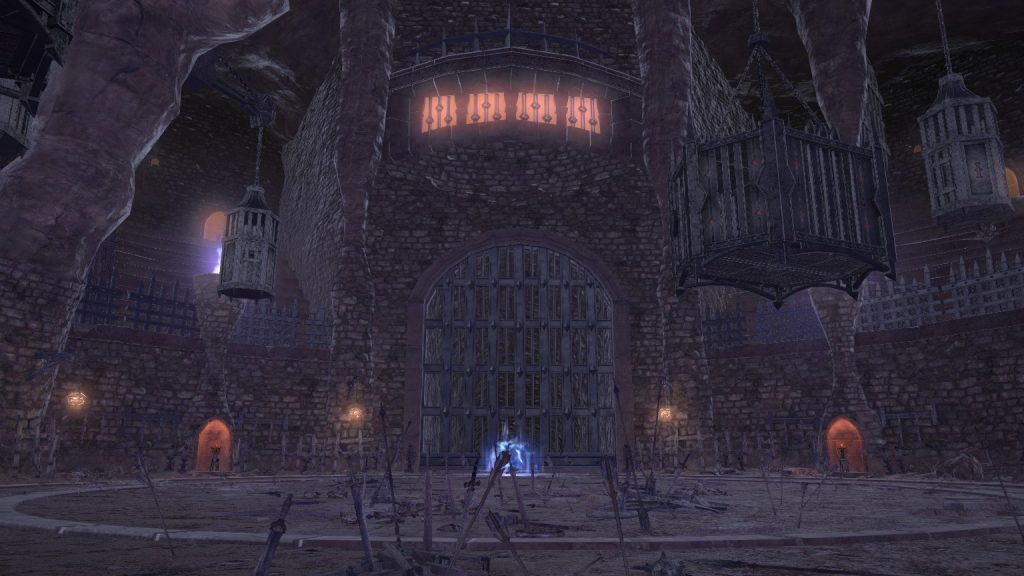Excerpt from ‘The history of Thanalan, from Belah’dia to Ul’dah’ by Archon Niniri Niri.
Halatali is a more ancient and revered site than the vast majority of those who attend fights facilitated by it on the Bloodsands would ever know. Piecing together what few records survive with folklore and archaeological evidence has revealed that Halatali was a system of naturally-occurring caves that were found by Lalafell who escaped the terror of the fall of Mhach. They settled here, naming it Halatali, which translates to ‘the land of a thousand shadows’ in honor of its role in protecting them from Thanalan’s baleful sun, and would later go on to found Belah’dia.
This status persisted until later in the life of Belah’dia’s successor, Ul’dah, however, when Halatali was transformed from a sacred reminder of history to a center of the Gladiator’s Guild. In the year of 1481 the caves became a training complex, as well as hosting the beasts used within the Coliseum. This continued for the next near-century of Ul’dahn history until the cataclysmic destruction of the Seventh Umbral Calamity. The lives of all Eorzeans were disrupted on that day, and Halatali was a cost that the reeling Sultanate could not sustain. The complex was sealed, the beasts and captives within left abandoned.
Five years later, much recovered, the Sultanate was in an adequate enough state that the Coliseum Foundation could send construction workers back into Halatali to recover it. They expected to find it filled with corpses to be disposed of, but instead they found the beastly survivors of the complex, honed to excellence through intense competition for food. Adventurers were sent into complex to cleanse the complex, and a few weeks afterwards this author led a research team into the complex’s depths.
The Red Wing
Upon descending into Halatali, the still-life of the gladiators that once inhabited the complex was immediately obvious. Discarded weaponry, armor racks and training dummies littered the area, still decorated with the scars of usage. The team emerged onto a raised platform at first, surrounded by the sundry items of gladiatorial training. This platform evidently functioned as a spectator area for the training circle below. The ferocity of Ul’dahn gladiator training is obvious here, judging by the looming cages above the circle, which must have been used to drop beasts amongst the trainees. The torches in this area and further on were lit, apparently by fire elemental spirits within Halatali.

Hall of the Cesti
One of the grander chambers within Halatali, the Hall of the Cesti is a chamber that was once devoted to training with cesti. Cesti were an innovation of early Ul’dah created out of the practice of wrapping leather around fighter’s knuckles. This practice later evolved to add grips to prevent slipping and metal bars to enhance damage. A large bonfire occupies the center of the room, perhaps used for ceremony, and is surrounded by a number of braziers.

The Green Wing
The befittingly named Green Wing appeared similar to its predecessor when the team arrived there, with the most dramatic difference being the sickly green glow that pervaded it. This wing also displayed much more of Halatali’s original cave nature than the previous wing did, being much less built upon. A mysterious miasma of green mist lurked in the pits beneath the walkways of the wing, which the team emphatically avoided lest it be dangerous. Further, the wing was host to a number of winches that granted access deeper within the complex, albeit most were apparently fitted with traps or even boons prior to the adventurer’s entry. This illustrates the wing’s role as a gauntlet for gladiator’s to use for training.

Hall of the Secutores
An open-air chamber, the Hall of the Secutores appears to have been partially flooded by rainfall in the years following Halatali’s sealing. Judging by the structure, however, it can be surmised that the chamber was once a fighting pit replete with a raised viewing platform, judging by the discarded weaponry within the pit as well as the beast cages hung above it. The name may suggest that this hall was specifically used for the training of those gladiators that employed the use of a sword and shield, as a secutor is just that.

The Yellow Wing
The final wing of Halatali is less unusual and disconcerting than the prior one and is also smaller, structured almost entirely around a single, albeit large, fighting pit. At the end of the wing is a large gate named the Ludus Door, a reference to the sports that took place and were venerated within Halatali.
Etymology Notes: Ludus is a latin term for playing, training or taking part in sport. It was used widely, from schools to ceremonial games and even to gladiator training facilities.

Hall of the Bestiarii
The jewel of Halatali is a modest coliseum, the Hall of the Bestiarii. It holds an array of raised seating for observers, and appears to have a windowed observation box, perhaps once host to high ranking members of the guild, the Syndicate or even the Sultanate itself. The name of the hall implies that beasts were fought primarily, or perhaps simply most famously, within the hall.
Etymology Notes: A Bestiarius was a gladiator in ancient Rome who fought specifically against beasts of various kinds, from lions to bears.





Leave a Reply